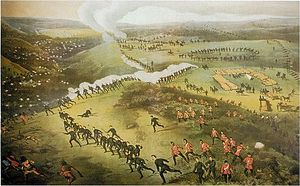Battle of Cut Knife
| Battle of Cut Knife | |||||||
|---|---|---|---|---|---|---|---|
| Part of the North-West Rebellion | |||||||
 Contemporary lithograph from The Canadian Pictorial and Illustrated War News. |
|||||||
|
|||||||
| Belligerents | |||||||
|
Cree Assiniboine |
|
||||||
| Commanders and leaders | |||||||
|
Poundmaker Fine Day |
William Dillon Otter | ||||||
| Strength | |||||||
| 50 to 250 | 350 | ||||||
| Casualties and losses | |||||||
| 5 dead 3 wounded |
8 dead |
||||||
| Official name | Battle of Cut Knife Hill National Historic Site of Canada | ||||||
| Designated | 1923 | ||||||
8 dead
14 wounded
The Battle of Cut Knife, fought on May 2, 1885, occurred when a small force of Cree and Assiniboine warriors were attacked by a flying column of mounted police, militia, and Canadian army regulars near Battleford, Saskatchewan. The warriors defeated the Canadian forces, with losses on both sides.
In the spring of 1885, the Métis living in the District of Saskatchewan formed a provisional government under Louis Riel, taking control of the area around . Soon, Riel began to contact the local natives; the Cree and the Assiniboine. The Canadian government decided to crush the separatist movement, afraid that it would spread to the tribes across the North-West Territories. Bands of Cree, assembled under the leadership of Poundmaker, went to Battleford to talk to the Indian agent, Rae. The purpose of the visit was to lobby Rae for better supplies (many members of the band were starving) and to discuss the political situation. The people of Battleford and some of the settlers in the surrounding area, hearing reports of large numbers of Cree and Assiniboine leaving reserves and making their way to Battleford, feared for their safety. On the night of March 30, 1885, townspeople began to abandon the town and seek shelter in the North-West Mounted Police Fort Battleford. When Poundmaker and his party reached the town, the Indian agent refused to come out of the fort to meet with them. He kept them waiting for two days.
Suffering from hunger and having been refused supplies by the Indian Agent meant to attend their well being, some of the party began looting the abandoned buildings. The identity of the looters is disputed. Some reports claimed Poundmaker's people were responsible, but one observer alleged that most of the looting had already been done by whites. Oral history accounts claim that the looting was done by Nakoda people, and that Poundmaker did his best to stop it. Either way, Poundmaker's people left the next day.
...
Wikipedia
